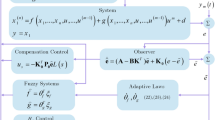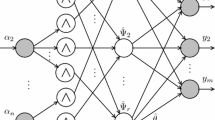Abstract
In this work, the Kalman Filter (KF) and Takagi–Sugeno fuzzy modeling technique are combined to extend the classical Kalman linear state estimation to the nonlinear field. The framework for such extension is given, and in this sense the discrete-time fuzzy Kalman filter (DFKF) is obtained. It will be shown that the fuzzy version gives some advantages when is compared with the Extended Kalman Filter (EKF), which is the most typical extension of the KF to the nonlinear field. The proposed approach provides a significantly smaller processing time than the processing time of the EKF while the mean square error is also reduced. Finally, some examples, such as the Lorenz chaotic attractor and under actuated mechatronic system (pendubot), are used to compare the DFKF and EKF.









Similar content being viewed by others
References
Abdallah ZS, Gaber MM, Srinivasan B, Krishnaswamy S (2016) AnyNovel: detection of novel concepts in evolving data streams an application for activity recognition. Evolv Syst 7(2):73–93
Angelov P, Yager R (2012) A new type of simplified fuzzy rule-based system. Int J Gen Syst 41(2):163–185
Castillo-Toledo B, Meda-Campaña JA (2002) The fuzzy discrete-time robust regulation problem: A LMI approach. Proc IEEE Conf Decis Control 2:2159–2164
Chui CK, Chen G (2009) Kalman filtering with real-time applications, 4th Edn. Springer, Berlin
Grewal MS, Andrews AP (2001) Kalman filtering: theory and practice using MATLAB, 2nd Edn. Wiley, New York
Iliadis L, Margaritis K, Maglogiannis I (2016) Timely advances in evolving neural-based systems special issue. Evol Syst. doi:10.1007/s12530-016-9164-6
Kallapur A, Petersen I, Anavatti S (2009) A discrete-time robust Kalman filter, American control conference. Hyatt Regency Riverfront, St. Louis
Kalman RE (1965) A new approach to linear filtering and prediction problems. Research Institute for Advanced Study, Baltimore
Kangin D, Angelov P, Iglesias JA (2016) Autonomously evolving classifier TEDAClass. Inf Sci 366:1–11
Khamassi I, Sayed-Mouchaweh M, Hammami M, Ghedira K (2016) Discussion and review on evolving data streams and concept drift adapting. Evol Syst. doi:10.1007/s12530-016-9168-2
Maciel L, Ballini R, Gomide F (2016) Evolving granular analytics for interval time series forecasting, Granular. Computing 1:213–224
Marques Silva A, Caminhas W, Lemos A, Gomide F (2014) A fast learning algorithm for evolving neo-fuzzy neuron. Appl Soft Comput 14:194–209
Meda-Campaña JA, Castillo-Toledo B, Chen G (2009) Synchronization of chaotic systems from a fuzzy regulation approach. Fuzzy Sets Syst 160:2860–2875
Meda-Campaña JA, Rodriguez-Valdez J, Hernandez-Cortes T, Tapia-Herreraand R, Nosov V (2015) Analysis of the Fuzzy controllability property and stabilization for a class of T-S Fuzzy Models. IEEE Trans Fuzzy Syst 23(2):291–301
Moallem P, Mousavi BS, Naghibzadeh S. Sh (2015) Fuzzy inference system optimized by genetic algorithm for robust face and pose detection. Int J Artif Intell 13(2):73–88
Pratama M, Lu J, Lughofer E, Zhang G, Anavatti S (2016a) Scaffolding type-2 classifier for incremental learning under concept drifts. Neurocomputing 191:304–329
Pratama M, Lu J, Anavatti S, Lughofer E, Lim C-P (2016b) An incremental meta-cognitive-based scaffolding fuzzy neural network. Neurocomputing 171:89–105
Precup R-E, Tomescu ML, Radac M-B, Petriu EM, Preitl S, Dragos C-A (2012) Iterative performance improvement of fuzzy control systems for three tank systems. Expert Syst Appl 39:8288–8299
Ruan D, Huang C (2000) Fuzzy sets and fuzzy information Granulation theory, selected papers by Lotfi A. Beijin Normal University Press, Zadeh
Rubio JJ (2015) Adaptive least square control in discrete time of robotic arms. Soft Comput 19(12):3665–3676
Rubio JJ (2016) Least square neural network model of the crude oil blending process. Neural Netw 78:88–96
Rubio JJ, Yu W (2007) Nonlinear system identification with recurrent neural networks and dead-zone Kalman filter algorithm. Neurocomputing 70(13):2460–2466
Song W, Liang J (2013) Difference equations of Lorenz System. Int J Pure Appl Math 83(1):101–110
Tanaka K, Wang HO (2001) Fuzzy control systems design and analysis: a linear matrix inequality approach. Wiley, New York
Terejanu GA (2008) Extended Kalman Filter Tutorial, Department of Computer Science and Engineering, University at Buffalo, Buffalo, NY
Venkatesan R, Er MJ, Dave M, Pratama M, Wu S (2016) A novel online multi-label classifier for high-speed streaming data applications. Evol Syst. doi:10.1007/s12530-016-9162-8
Wang L-X (1997) A course in fuzzy system and control, Prentice Hall International, Inc., NJ, p 424
Welch G, Bishop G (1985) An introduction to KalmanFilter, vol 4. Department of Computer Science, University of North Carolina at Chapel Hill, Chapel Hill
Acknowledgements
Authors want to express their deepest thank to CONACyT and Instituto Politécnico Nacional for the scholarships granted and research projects.
Author information
Authors and Affiliations
Corresponding author
Ethics declarations
Conflict of interest
The authors declare that they do not have conflict of interests.
Rights and permissions
About this article
Cite this article
Páramo-Carranza, L.A., Meda-Campaña, J.A., de Jesús Rubio, J. et al. Discrete-time Kalman filter for Takagi–Sugeno fuzzy models. Evolving Systems 8, 211–219 (2017). https://doi.org/10.1007/s12530-017-9181-0
Received:
Accepted:
Published:
Issue Date:
DOI: https://doi.org/10.1007/s12530-017-9181-0




